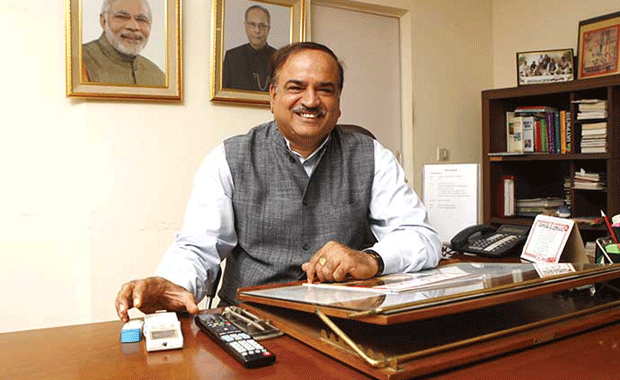“We have finalized mega plans to undo 10 years of neglect”
Mr Ananth Kumar Union Minister for Chemicals and Fertilizers, Government of India
Mr Ananth Kumar, the Union Minister for Chemicals and Fertilizers in the present Government, is set for big things. He has brought in a fresh thought process into his ministry, and has charted out a very detailed road map for galvanizing India’s chemical, petrochemical and fertilizer sectors. If his plans are implemented on time, then India’s economic performance will surely be applauded, and investments of billions of dollars will pour in. The buzzword of Make In India will also get actuated on the ground. The clarity with which he speaks on a range of issues shows why he is able to strike a chord with his electorate year after year—he has been elected 6 consecutive times to the Lok Sabha from the Bengaluru South constituency of Karnataka. In the 2014 Lok Sabha elections he was pitted against the Congress party’s Nandan Nilekani, a former co-founder of Infosys and architect of the Aadhar card. Yet Mr Nilekani could not unsettle the heavyweight BJP leader from south India and lost by over 2.28 lakh votes. Mr Kumar won on the strength of his “tried, tested, trusted” campaign line. He had held several ministerial positions in the Atal Bihari Vajpayee Government. Today he is among a crop of young BJP ministers who are tasked to plan and deliver on the promises made by the party on bringing about India’s economic and social turnaround. He spoke to India Empire Editor Sayantan Chakravarty at his Parliament office
As an initiative under Make in India, you have taken a decision to fast-track growth in Petroleum, Chemical and Petrochemcial Investment Regions (PCPIRs) in 4 states to attract investments to the tune of Rs 7.63 lakh crore and generate employment of 33.96 lakh. How is this progressing?
During the UPA period the entire thing was in limbo. To make such a thing happen, you require anchor tenants. Once you have identified them, you have to bring on the table state Governments. Then you need to have a steering committee. After all, the process of creating infrastructure in hundreds of square kilometers is detailed, and long. It is about attracting investments from across the globe, in order to make India a petrochemical hub. You bring in crude, refine it using cracker units to get the C2, C3, C4 and downstream industries. Then you create building blocks, then the plastic parks, pharmaceutical companies, fertilizer companies. It is an entire chain which to be completed requires railroad links, aviation and telecommunication facilities. All this combines to make a mega park. After our Government has taken over, Dahej as a brownfield PCPIR is almost ready. Paradip has started rolling. We have held meetings for Vishakapatnam, and Nagapatnam in Chennai is going to happen. To these four we are adding a few more—Madhya Pradesh, Karnataka and Rajasthan are ready to have PCPIRs. Maharashtra is also looking positively to have one. In India you have 22 refineries but there are only four petrochemical complexes. It is a real anomaly. You can, therefore, go from 4 to 22, and you can go from 2.5 per cent value addition to 7.5 per cent value addition, which means instead of Rs 10 lakh crore of investment you can go up to Rs 30 lakh crore of investment, and from generating 37 lakh jobs to generating over 100 lakh jobs. We are using 230 million of litres of crude, and this value addition requires to be done. We need to milk the fuel.











Comments.